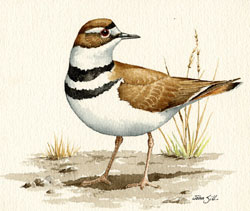Breeding Bird Atlases (BBA)
Find a Bird - BBA1
Breeding Bird Atlas 1 Species Accounts
Killdeer
Charadrius vociferus
Egg Dates
April 15 to July 20
Number of Broods
one or two

The wanton destruction of birds, especially shorebirds, at the turn of the century nearly extirpated the Killdeer as a breeding species in the state. Its numbers quickly recovered when it was afforded protection, and it soon reoccupied much of its former breeding range. At present, the Killdeer is a widespread but fairly common breeding resident and, although long established on Martha’s Vineyard, is rather rare on Cape Cod and Nantucket. Killdeer are scarce in the higher elevations of Worcester and Berkshire counties but do nest there wherever suitable habitat is found.
This species is among the earliest spring migrants to arrive in our area. In normal years, Killdeer appear by the middle of March, but in exceptionally warm years they may return in late February. Early arrivals are found in agricultural fields, congregating around snowless areas where manure has been spread for fertilizer. By mid-April, Killdeer are present in a variety of open areas, where they will establish territories for nesting. These include fields, pastures, airports, golf courses, playgrounds, gravel pits, beach dunes, unpaved driveways, and lawns. In recent years, they have taken to nesting on the flat rooftops of one- or two-story buildings. Despite the questionable suitability of the latter nesting sites, there is evidence that some young are raised to maturity.
The Killdeer derives its name from its familiar call, a strident killdee, killdee. When approached in the vicinity of its nest, the bird announces its agitation by uttering a rolling call that often introduces or accompanies its elaborate distraction display. Another vocalization frequently given in the proximity of the nest or chicks is a nervous dee, dee, dee, dee.
Killdeer usually lay four eggs in a nest scrape lined with pebbles or grass, as was the case for eight Massachusetts nest records from various sources. If the first nest is lost, the birds generally will lay another set of eggs, and some pairs may rear two broods. Both sexes take an equal share in the 25-day incubation period. Once the eggs hatch, the young almost immediately are capable of moving about and feeding themselves. There is an interesting Massachusetts record of a male taking 2 mates and 1 female deserting her four eggs to help care for the young of the other female (CNR). The young fly about 25 days after hatching.
When a potential predator draws too close to the young, the parent begins a classic distraction display, which includes flopping along the ground with its wings dragging as though injured and constantly flashing its brightly marked tail. This conspicuous behavior takes place only in the presence of the nest site or young and is the major evidence of proven breeding.
In late summer, small groups of Killdeer are found in open areas near the breeding sites. It is not until late September or early October, when fields are fallow and again suitable for Killdeer, that larger flocks occur. During this period, the birds are most common in the interior river valleys and the southeastern portion of the state. By mid-November, most individuals have departed for wintering grounds in the southern United States. A few linger or attempt to overwinter at coastal locations.
Map Legend and Data Summary
Atlas 1 data collected from 1975-1979


Note: fairly common and widespread in a variety of open habitats including parks and playgrounds; absent on Nantucket
Richard A. Forster



